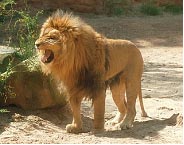|

Our first stop starts at the heart of South Africa. I am sure most of you have heard about the Big Five. These include: Lion,
Leopard, Elephant, Rhinoceros, and Buffalo.
We will first meet the Lion; At one time these proud and majestic cats occurred widely in Europe, over much of Asia
and the continent of Africa. Today, they are extinct in Europe, extremely threatened in Asia, and occur only in protected
areas south of the Sahara in Africa.
The lion is the largest of the African carnivores, with males weighing up to 240kg and standing 125cm at the shoulder.
Females, or lionesses, are lighter and smaller. Adults are generally a uniform tawny colour, but some maintain the spots that
are characteristic of young lions. The backs of the ears are black and contrast sharply with the colour of the body. Adult
males have a very distinctive and attractive mane of long hair on the sides and top of the face which extends down beyond
the shoulders. In addition to the mane, some males have clumps of long hair on the elbows and on the chest extending to the
stomach.
Lions are the only cats that are distinctly social, living and hunting in prides which may number well over 30 individuals.
They occur in areas where their prey is concentrated and where cover is sometimes limited for stalking and it is therefore
to their advantage to form prides and assist each other with hunting. They try and avoid encounters with other lions, relying
on roaring, scent marking and patrolling to demonstrate their right to a particular area. Lionesses form the core of the pride,
rarely moving out of the area in which they were born. Lions hunt mainly at night and are expert stalkers. Males take precedence
at a kill, followed by the females, with the cubs very often having to make do on leftover scraps.
Man is the only significant enemy of the lion, but this has been enough to drive them from most of their former range.
They are vulnerable to injury through hunting and fighting and when hurt or too old to hunt effectively, they may become man-eaters.
Lions can run at 58 km/h, which is too slow to catch most antelope, and stalking is therefore a very important part of their
hunting strategy. They kill mostly by strangling or by clamping their mouths over the prey's muzzle. Other pride members do
not wait until the victim is dead before they start feeding, and when sufficient food is available.
Back to Run Wild with Nelak
Back to Running Wild
|



